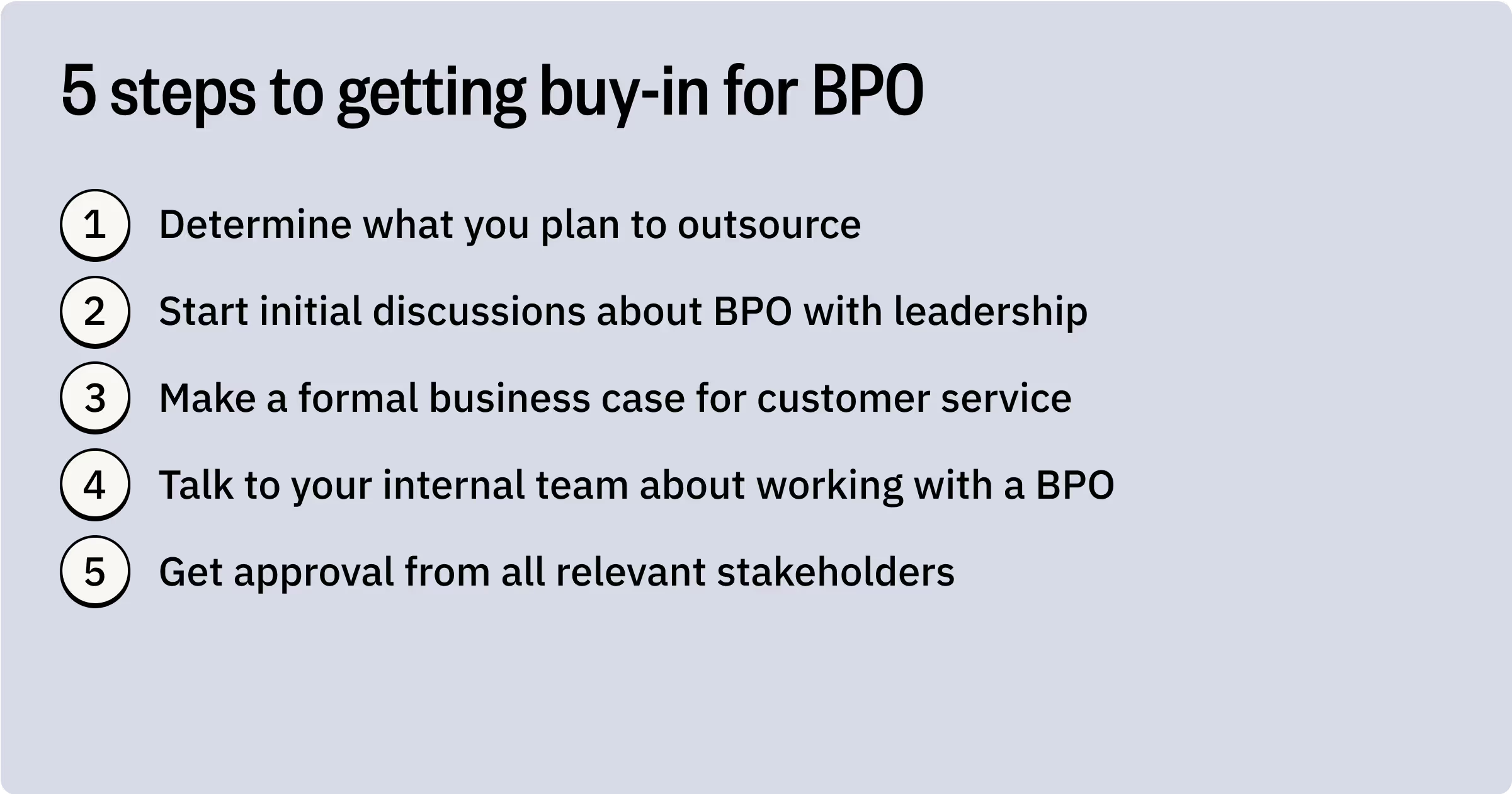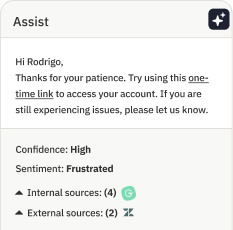How to get buy-in for customer service outsourcing

Outsourcing isn’t just about plugging gaps or saving costs anymore. It’s a strategic move for support teams ready to scale and optimize. As labor shortages and rising customer expectations converge with omnichannel support, BPOs are critical partners in delivering high standards without burning out your internal team. Here’s how to get the buy-in for outsourcing and unlock its full potential in transforming your support operations.
Why now is the time for customer service outsourcing
Support teams have faced dramatic shifts in recent years, with call volumes rising and customers demanding faster responses. According to a recent McKinsey & Company survey, 57% of customer care leaders anticipate a 20% increase in call volume over the next few years.
More demand is a good sign — it means your team’s value is clear. But managing this surge while maintaining quality isn’t easy, especially when 72% of customers want immediate service. This is where outsourcing can be a game-changer. BPOs offer the agility to scale quickly, handle spikes in demand, and free up your internal team to focus on high-value interactions. By leveraging BPOs strategically, you’ll maintain top-notch customer service without sacrificing speed or efficiency.
5 steps to secure buy-in for customer service outsourcing
It’s one thing to recognize that outsourcing is the right move for your support team, but another to get leadership on board. So how do you convince decision-makers? Here are five actionable steps to help you get the green light for customer service outsourcing, positioning it as the strategic advantage your team needs to scale and thrive.

1. Determine what you plan to outsource
One of the biggest advantages of outsourcing is how flexible it can be. You have countless ways to split the work between your internal team and your BPO. To find the right balance, start by identifying your pain points: Are SLAs slipping as contact volumes rise? Are your agents unfamiliar with a new support channel? Struggling to cover off-peak shifts?
You can think about outsourcing in two primary ways:
Outsourcing to optimize: Streamline operations by assigning certain channels, types of issues, or specific times of the day to a BPO. This helps you improve efficiency and keep costs in check.
Outsourcing to expand: Extend your support coverage by working with a BPO for new offerings, geographies, or specialized services. This option makes sense when it’s not practical to rely on your in-house team for expansion.
Still unsure what’s best to outsource? Consider these guiding questions from ICMI:
- Is this task critical to your core success? If so, keep it in-house for better control. For instance, you wouldn't outsource complex problems that require deep knowledge of your products.
- Is this something the BPO excels at? Lean into the strengths of your vendor to relieve your team and maintain high quality.
- Does the vendor have more expertise in this area than you? If a BPO is better equipped for real-time troubleshooting, make the most of their skills.
Finally, remember that outsourcing is a strategic tool, not a drawback. A CCW Digital report points out that outsourcing can be a smart way to leverage local expertise in new markets. For instance, BPO agents based in your expansion region will understand the language and nuances of the area, delivering a better customer experience.
With a BPO partner who specializes in what they do, you can provide exceptional service while scaling your operations.
2. Start initial discussions about BPO with leadership
You know the importance of data when building a case. But before you dive into gathering numbers to back up your pitch for outsourcing, hit pause. There’s no sense in building charts and graphs only to face a hard “no” from leadership. Instead, ease into it. Start by sharing the big-picture benefits.
According to ICMI’s State of the Contact Center report, customer service outsourcing leads to:
- Lower operating costs
- Increased productivity
- Greater staffing flexibility
Expect some initial resistance, but don’t shy away from showing how outsourcing can maintain or even elevate your service standards.
3. Make a formal business case for customer service outsourcing
Now that you’ve secured some initial support for outsourcing customer service, it’s time to dive deeper and make your case. This likely involves a formal presentation with plenty of data, but don’t overlook the importance of clearly explaining your reasoning upfront.
If you’ve chosen to either optimize or expand through outsourcing, walk your leadership team through why that decision makes sense. For example, if you’re launching a new channel, emphasize that this is uncharted territory for your internal team. Detail the resources and training required to get them up to speed, then contrast that with how much more cost effective and efficient it would be to outsource this function from the start.
Of course, you’ll need concrete numbers to back this up. You can run the calculations yourself with some general assumptions. For example, it’s widely accepted that the actual cost of in-house agents is around two to two-and-a-half times their base hourly rate when you account for benefits, training, facilities, and more. So, for an agent making $20 per hour, the actual cost could be closer to $40 or $45 per hour. By contrast, the rate a BPO charges already covers all these expenses.
This gives you a rough estimate of potential cost savings, but there’s an even more reliable option. If you’re in discussions with BPO providers, they’ll often help you draft a full return on investment (ROI) analysis, using real data. Since they want your business, don’t hesitate to ask for their input to strengthen your case.
With strong evidence showing how outsourcing will benefit the organization, you’ll likely find leadership more open to the idea than you expected.
4. Talk to your internal team about working with a BPO
Once you’ve secured buy-in from leadership, it’s crucial to communicate with your internal support team. No one wants to feel blindsided by a new BPO partnership. The key here is framing. Start by reassuring your team that their jobs are secure — outsourcing isn’t about them underperforming.
Explain how partnering with a BPO is actually a strategic move to future-proof the organization. Whether it’s expanding into new regions or offloading repetitive tasks, emphasize that this allows them to focus on the more impactful, fulfilling work they’re best at.
Next, outline what onboarding will look like — how you’ll train BPO agents, the tools they’ll use, and how they’ll fit into the team. When done right, BPO agents will feel like an extension of your current team, making the transition seamless and beneficial for everyone involved.
5. Get approval from all relevant stakeholders
Once leadership and your internal team are on board, the next step is getting approval from other stakeholders. Outsourcing impacts various departments, so it’s key to bring everyone into the conversation early.
For example, your IT department will need reassurance on security protocols and data access. Engaging them upfront ensures your contract with the BPO addresses these concerns.
You’ll also need input from finance, legal, and sales. Their feedback helps you craft a comprehensive contract that aligns with company-wide needs. Once you’ve got their approval, you’re all set to move forward with outsourcing. Congrats — you’ve earned it!
Make customer service outsourcing work for you
Once you’ve got the go-ahead for customer service outsourcing, it’s time to think about selecting the right vendor and ensuring your BPO agents feel supported. Making them feel like part of your team goes a long way in building a successful partnership — and happier agents mean happier customers. The training and incentives you provide will directly impact their morale and performance.
At the same time, don’t forget to prepare for the BPO selection and management process. Research, RFPs, and contract negotiations are just a few steps ahead.





